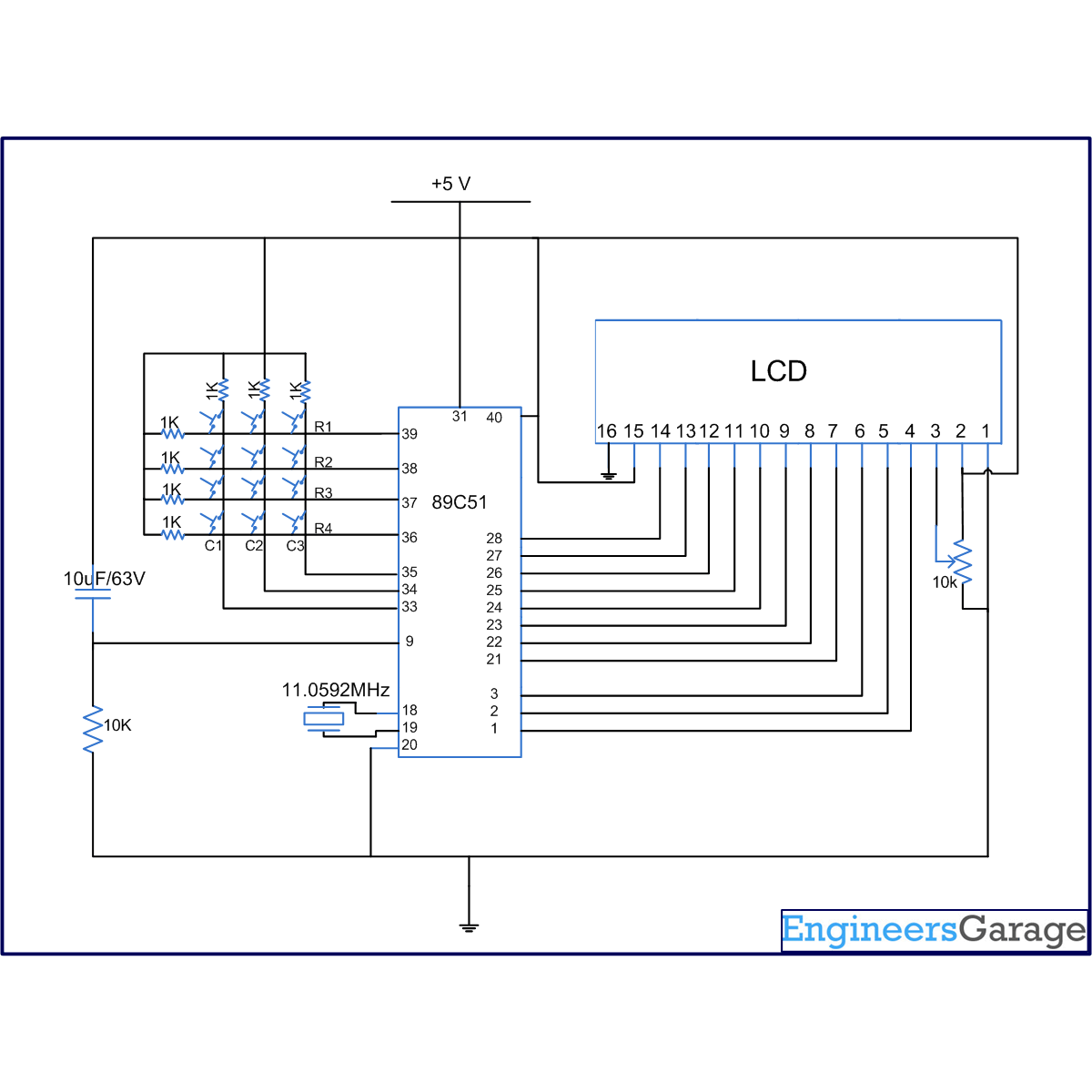There are several electronic devices which require a security lock for their protection. This article describes a way to build an electronic lock with a four-digit password. A keypad, interfaced with 8051 microcontroller (AT89C51), is used to enter the password. The password and its status are displayed on an LCD screen.
A 4×3 matrix keypad and a 16×2 LCD have been used here. Keypad and LCD are very commonly used input & output devices, respectively. A four digit predefined password is specified in the microcontroller AT89C51‘s program. If the entered password from keypad matches with this password, then the lock opens and a message is displayed on LCD. Also an output pin is made high to be used for further purpose.
Project Source Code
###
//Program to make a simple code lock. The default password is 3907. #include<reg51.h> #define port P1 #define dataport P2 #define key P0 #define sec 100 sbit rs = port^0; sbit rw = port^1; sbit en = port^2; sbit col1=key^4; sbit col2=key^5; sbit col3=key^6; sbit row1=key^0; sbit row2=key^1; sbit row3=key^2; sbit row4=key^3; sbit lock_output=P0^7; int check=0; int digit[4]={0,0,0,0}; int dig_one=3; int dig_two=9; int dig_three=0; int dig_four=7; int i,count=0; void delay(unsigned int msec) //Time delay function { int i,j ; for(i=0;i<msec;i++) for(j=0;j<1275;j++); } void lcd_cmd(unsigned char item) //Function to send command to LCD { dataport = item; rs= 0; rw=0; en=1; delay(1); en=0; return; } void lcd_data(unsigned char item) // Function to send data to LCD { dataport = item; rs= 1; rw=0; en=1; delay(1); en=0; return; } void lcd_data_string(unsigned char *str) // Function to send string to LCD { int i=0; while(str[i]!='�') { lcd_data(str[i]); i++; //delay(10); } return; } void lcd(unsigned char str[10]) // Function to send string to LCD { lcd_cmd(0x38); lcd_cmd(0x0e); lcd_data_string(str); } void ans() { if(check>3) { lcd_cmd(0x01); lcd_cmd(0x82); lcd_data_string(" LOCK OPEN"); lock_output=1; delay(500); } else { lcd_cmd(0x01); lcd_cmd(0x82); lcd_data_string(" WRONG PASSWORD"); lock_output=0; count++; delay(500); } } void code_check() // Function to check password { if(i<=3 ) { switch((i+1)) { case 1: { if(dig_one==digit[0]) { check=check+1; } break; } case 2: { if(dig_two==digit[1]) { check=check+1; } break; } case 3: { if(dig_three==digit[2]) { check=check+1; } break; } case 4: { if(dig_four==digit[3]) { check=check+1; } break; } } } if(i==3) { ans(); } } void display(int a) //Display function { switch(a) { case 1:{ lcd_data('1'); delay(30); digit[i]=1; code_check(); break; } case 2:{ lcd_data('2'); delay(30); digit[i]=2; code_check(); break; } case 3:{ lcd_data('3'); delay(30); digit[i]=3; code_check(); break; } case 4:{ lcd_data('4'); delay(30); digit[i]=4; code_check(); break; } case 5:{ lcd_data('5'); delay(30); digit[i]=5; code_check(); break; } case 6:{ lcd_data('6'); delay(30); digit[i]=6; code_check(); break; } case 7:{ lcd_data('7'); delay(30); digit[i]=7; code_check(); break; } case 8:{ lcd_data('8'); delay(30); digit[i]=8; code_check(); break; } case 9:{ lcd_data('9'); delay(30); digit[i]=9; code_check(); break; } case 0:{ lcd_data('0'); delay(30); digit[i]=0; code_check(); break; } } } void check_col1() { row1=row2=row3=row4=1; row1=0; if(col1==0) display(1); row1=1; row2=0; if(col1==0) display(4); row2=1; row3=0; if(col1==0) display(7); row3=1; row4=0; if(col1==0) { row4=1; } } void check_col2() { row1=row2=row3=row4=1; row1=0; if(col2==0) display(2); row1=1; row2=0; if(col2==0) display(5); row2=1; row3=0; if(col2==0) display(8); row3=1; row4=0; if(col2==0) display(0); row4=1; } void check_col3() { row1=row2=row3=row4=1; row1=0; if(col3==0) display(3); row1=1; row2=0; if(col3==0) display(6); row2=1; row3=0; if(col3==0) display(9); row3=1; row4=0; if(col3==0) { row4=1; } } void main() { col1=col2=col3=1; while(1) { lcd_cmd(0x01); //Clear LCD screen lock_output=0; lcd_cmd(0x82); // Set cursor on position first of first line lcd("ENTER PASSWORD"); check=0; row1=row2=row3=row4=0; while(col1==1 && col2==1 && col3==1); for(i=0;i<4;i++) { delay(100); lcd_cmd(0xc4+i); row1=row2=row3=row4=0; while(col1==1 && col2==1 && col3==1); row1=row2=row3=row4=0; if(col1==0) check_col1(); else if(col2==0) check_col2(); else if(col3==0) check_col3(); if(count==4) { lcd_cmd(0x01); lcd_cmd(0x86); lcd("SORRY"); lcd_cmd(0xc1); lcd("NO MORE TRIALS"); while(1); } } } }###
Circuit Diagrams
Project Components
Project Video
Filed Under: 8051 Microcontroller.
Filed Under: 8051 Microcontroller.



Questions related to this article?
👉Ask and discuss on EDAboard.com and Electro-Tech-Online.com forums.
Tell Us What You Think!!
You must be logged in to post a comment.